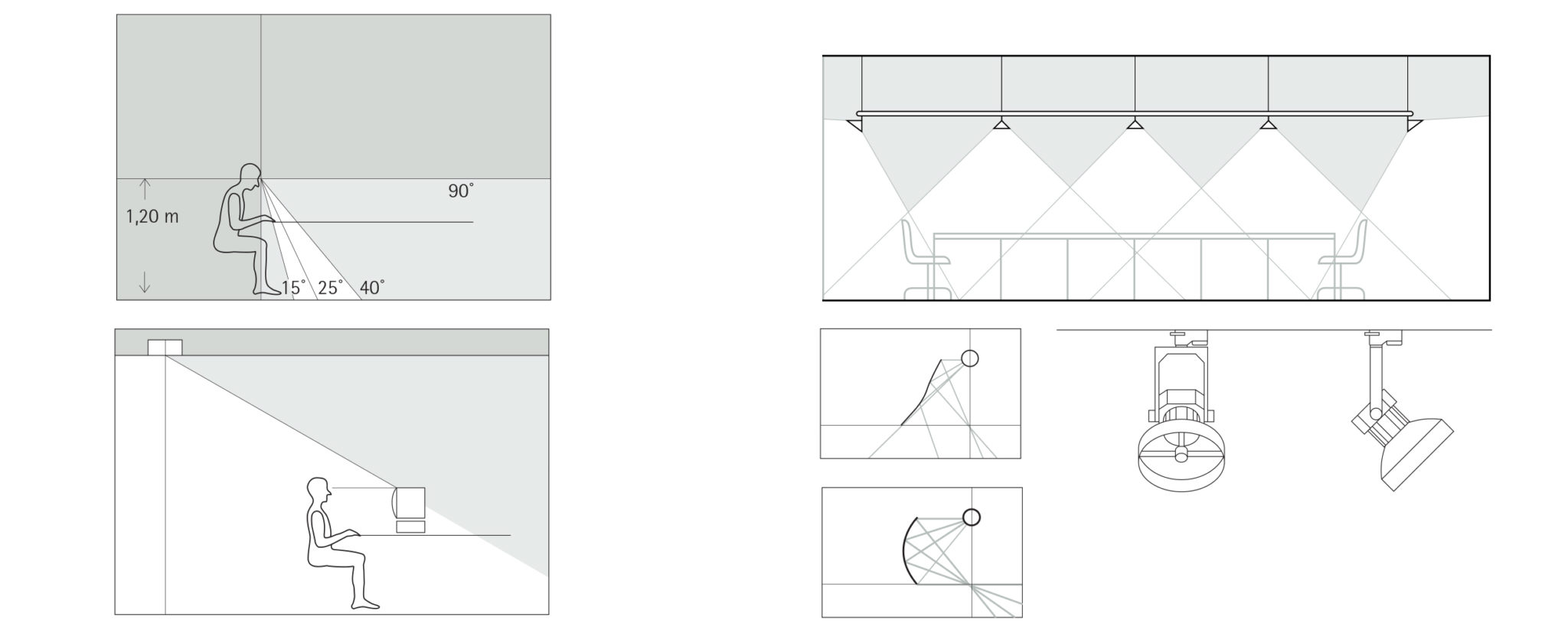
(EN)
Type: Book / E-book
Publisher: Verlag Vieweg
Pages: 289
Publication: 1992
Written by Rüdiger Ganslandt and Harald Hofmann, Erco’s Handbook of Lighting Design was first published in 1992. It provides a comprehensive guide covering everything from the history and basics of lighting design to lighting theories, technical information, and lighting concepts. Anyone interested in the topic, whether you are an architecture student, a lighting designer, a contractor, a house owner, a business owner, or an art curator, will benefit from this book in varying degrees without needing prior knowledge of lighting design.
The 289-page book starts with an introduction to the history of architectural lighting. From the time architecture was designed out of the necessity of natural light. The development of artificial lighting came a long way to electrical lighting. The endless possibilities for technology then were unlocked, and there were no longer limitations to what artificial lights could do.
The second chapter, Basics, provides scientific theories, facts, and information related to lighting design that might come in handy. The chapter is accompanied by illustrations and information tables that are extremely useful. The topics in Basics include Perception, Terms and units, Light and light sources, Control gear and control equipment, Light – qualities and features, Controlling light, and Luminaires.
The third chapter, Lighting Design, deals with applying the theoretic principles introduced in the last chapter to the practicality of designing the way the lights illuminate. Topics included are Lighting design concepts, Qualitative lighting design, and Practical planning. The chapter is packed with technical information worthy of a handbook for a professional.
Chapter four, Examples of lighting concepts, provides lighting design scenarios for different kinds of space. Types of lamps, installation layouts, and light beams needed for spaces such as foyers, lift lobbies, corridors, staircases, different kinds of offices, conference rooms, auditoriums, eateries, museums, showcases, vaulted ceilings, sales areas, exhibitions.
Erco’s Handbook of Lighting ตีพิมพ์ครั้งแรกในปี 1992 โดยมี Rüdiger Ganslandt และ Harald Hofmann เป็นผู้เขียน หนังสือเล่มนี้ให้คำแนะนำและทำหน้าที่เป็นคู่มือที่ครอบคลุมตั้งแต่ประวัติศาสตร์และพื้นฐาน ไปจนถึงทฤษฎี ข้อมูลทางเทคนิคสำหรับการปฏิบัติงาน และตัวอย่างการออกแบบแสงสำหรับพื้นที่สำหรับวัตถุประสงค์ต่างๆ โดยมีจุดประสงค์ให้ผู้อ่านที่มีความสนใจ ไม่ว่าจะเป็นนักศึกษาสถาปัตยกรรม นักออกแบบแสง ผู้รับเหมา เจ้าของบ้าน เจ้าของธุรกิจ หรือภัณฑารักษ์ ได้รับประโยชน์จากหนังสือเล่มนี้ไม่มากก็น้อย โดยไม่จำเป็นต้องมีความรู้ด้านการออกแบบแสงสว่างมาก่อน
หนังสือเล่มนี้ประกอบไปด้วย 289 หน้า ในบทแรก History พูดถึงประวัติศาสตร์ของการออกแบบสถาปัตยกรรมที่คำนึงถึงแสงธรรมชาติตามสภาพภูมิอากาศของโลก และแสงประดิษฐ์ที่เริ่มต้นขึ้นเมื่อหน้าที่ในการให้แสงสว่างของเปลวไฟถูกแยกออกจากหน้าที่ในการให้ความร้อน การพัฒนาดำเนินมาอย่างยาวนานจนกระทั่งมีการประดิษฐ์หลอดไฟฟ้าที่ปลดล็อคข้อจำกัดของแสงประดิษฐ์ ซึ่งนำไปสู่ความเป็นไปได้ไม่มีที่สิ้นสุด
ในบทที่สอง Basics นำเสนอพื้นฐาน ทฤษฎีทางวิทยาศาสตร์ ข้อเท็จจริง และข้อมูลการคำนวณที่เป็นประโยชน์สำหรับการออกแบบแสง บทนี้มาพร้อมกับภาพประกอบและตารางข้อมูลที่เข้าใจง่าย หัวข้อต่างๆได้แก่ Perception (การรับรู้) Terms and units (ศัพท์และหน่วยวัด) Light and light sources (แสงและแหล่งที่มาของแสง) Control gear and control equipment (เครื่องมือและอุปกรณ์ควบคุม) Light – qualities and features (คุณภาพและคุณสมบัติของแสง) Controlling light (การควบคุมแสง) และ Luminaires (โคมไฟ)
บทที่สาม Lighting Design (การออกแบบแสง) เป็นส่วนที่นำหลักการทางทฤษฎีในบทก่อนหน้าไปสู่การหลักปฏิบัติในการออกแบบ หัวข้อในบทนี้ได้แก่ Lighting design concepts (แนวคิดการออกแบบแสงสว่าง) Qualitative lighting design (การออกแบบแสงสว่างเชิงคุณภาพ) และ Practical planning (การวางแผนเชิงปฏิบัติ) บทนี้เต็มไปด้วยข้อมูลทางเทคนิคที่สมกับเป็นคู่มือสำหรับมืออาชีพ
บทที่สี่ Examples of lighting concepts (ตัวอย่างแนวคิดการจัดแสง) รวบรวมตัวอย่างการออกแบบการแสงสำหรับพื้นที่ประเภทต่างๆตามวัตถุประสงค์การใช้งาน แนะนำประเภทของโคมไฟ รูปแบบการติดตั้ง รวมถึงแสดงภาพประกอบที่อธิบายลำแสงสำหรับพื้นที่รูปแบบต่างๆ เช่น ห้องโถง โถงลิฟต์ ทางเดิน บันได สำนักงาน ห้องประชุม หอประชุม ร้านอาหาร พิพิธภัณฑ์ ตู้โชว์ พื้นที่ภายในอาคารที่มีเพดานโค้ง พื้นที่ร้านค้า และนิทรรศการ
